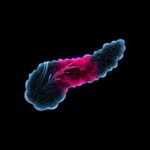What is already known
Previous studies have shown that disruptions in meal timing and gut bacteria play a role in rheumatoid arthritis — a long-term condition causing inflammation in the joints in a pattern that changes over time. However, how exactly these patterns of inflammation work remains unclear.
What this research adds
Researchers found that inflammation in people with rheumatoid arthritis peaks in the early morning and decreases by afternoon. Specific gut bacteria, particularly Parabacteroides distasonis, could reduce inflammation through a process involving a specific enzyme that produces a compound called glycitein. In mice, blocking this enzyme worsened inflammation, but adding glycitein restored its protective effect. Both P. distasonis and glycitein levels showed daily fluctuations in people with rheumatoid arthritis.
Conclusions
The results suggest that P. distasonis and glycitein help regulate inflammation associated with rheumatoid arthritis. The findings could guide treatment strategies for this condition.
Rheumatoid arthritis is a long-term autoimmune disease that causes inflammation and joint damage, leading to disability. New research suggests that specific gut bacteria and the compounds they produce help regulate inflammation associated with the condition.
The findings, published in Cell Metabolism, could guide treatment strategies for rheumatoid arthritis, which is characterized by a pattern of inflammation that changes over time. However, how exactly these patterns of inflammation work remains unclear.
Previous studies have shown that disruptions in meal timing and gut bacteria play a role in rheumatoid arthritis. So, researchers led by Fopei Ma at Southern Medical University in Guangzhou, China, set out to study inflammation patterns and gut microbes in people and mice with the condition.
Meal timing
The team found that inflammation in people with rheumatoid arthritis peaks in the early morning and decreases by afternoon. Certain bacteria, such as Prevotella copri, are linked to increased inflammation, while others, including Faecalibacterium, are associated with reduced inflammation levels.
In mice, which are active during the night, inflammation patterns were reversed. Changing feeding times affected inflammation, while exposure to light did not. However, when the researchers eliminated the animals’ gut bacteria, feeding patterns no longer influenced inflammation.
This result indicates that gut bacteria play a key role in how meal timing affects inflammation, the researchers say.
Daily rhythm
Further experiments in mice suggested that a specific gut microbe, called Parabacteroides distasonis, could reduce inflammation. P. distasonis produces a compound called glycitein through an enzyme known as beta-glucosidase.
Blocking beta-glucosidase in P. distasonis worsened inflammation, but adding glycitein restored its protective effect. Glycitein works by suppressing inflammatory pathways, the researchers found. In people with rheumatoid arthritis, both P. distasonis and glycitein levels showed daily fluctuations.
“Our findings not only corroborate the significance of dietary timing in modulating the rhythmicity of inflammation in [rheumatoid arthritis] but also emphasize the potential of targeting gut microbiota in the management of [rheumatoid arthritis],” the authors say. “Understanding the diurnal oscillations of gut microbiota in the pathogenesis of [rheumatoid arthritis] opens up potential avenues for therapeutic interventions, such as timing the administration of prebiotics or medications to align with the microbiota’s natural rhythms.”









